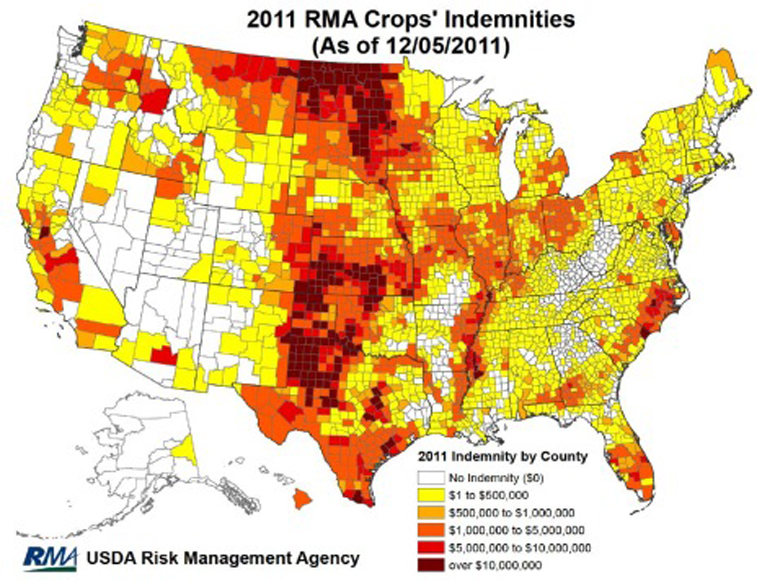
Agricultural News
Crop Insurance Companies Pay More Than $7.1 Billion in 2011
Thu, 15 Dec 2011 10:00:45 CST
 Crop insurance companies have paid out more than $7.1 billion and climbing in claims so far this year, which makes 2011 second only to 2008's $8.6 billion in the total value of indemnities paid out to farmers. The combination of several large-scale floods in the Central U.S., record droughts in the southern plains, a strong tropical storm in the Northeast and a hard freeze in Florida set the stage for the widespread agricultural losses.
Crop insurance companies have paid out more than $7.1 billion and climbing in claims so far this year, which makes 2011 second only to 2008's $8.6 billion in the total value of indemnities paid out to farmers. The combination of several large-scale floods in the Central U.S., record droughts in the southern plains, a strong tropical storm in the Northeast and a hard freeze in Florida set the stage for the widespread agricultural losses.
But what is the significance of this? The fact is that despite being one of the worst weather years in recent history, farmers had a policy backstop in place crop insurance to preclude major losses from natural disasters or market fluctuations that could lead to widespread bankruptcies and foreclosures.
Thankfully, Congress had the foresight to make decades of significant investments in crop insurance infrastructure, increase the varieties of crops covered and policies available as well as augmenting resources to increase farmer participation. The net result is the resilient and robust modern-day crop insurance policy.
But it hasn't always been this way. Although the program was originally launched in 1938, it was not particularly successful because program costs were high and participation by farmers was low. In 1980, Congress passed legislation designed to increase participation in the crop insurance program and make it more affordable and accessible for farmers. This modern era of crop insurance was marked by the introduction of a public-private partnership between the U.S. government and private insurance companies. Despite these changes, farmer participation remained low, averaging about 30 percent.
Low farmer participation in crop insurance combined with several large natural disasters set the stage for today's crop insurance policy. A major drought in 1988 spurred the first of what would be the last costly string of federal ad hoc disaster assistance bills for farmers. Another ad hoc disaster bill was passed in 1989; a third one enacted in 1992 gave farmers the option of claiming disaster losses on a farm-by-farm basis for any year between 1990 and 1992, and then an extremely wet and cool growing season in 1993 caused more losses, and Congress passed yet another ad hoc disaster bill.
Low farmer participation remained a major hurdle. Congress enhanced the crop insurance program in 1994 and again in 2000 in order to encourage greater participation. They accomplished this by combining federal dollars with farmer premiums to make otherwise cost-prohibitive crop insurance policies universally affordable to farmers of all sizes. The changes also expanded the role of the private sector in developing new products that would help farmers manage their risks. With these additional changes, farmer participation in the policy greatly expanded.
By 1998, more than 180 million acres of farmland were insured under the program, representing a three-fold increase over 1988. By 2010, roughly 80 percent of eligible farm land including all major grain crops and cotton, nursery, citrus, rice, potatoes, and livestock, covering more than 256 million acres of farmland and valued at nearly $80 billion, were protected by private crop insurance policies.
As the number of acres covered by crop insurance policies grew, so did the cost of the program along with it. Another factor that has driven up the cost of the policy is the recent dramatic rise in commodity prices. As the value of crops rise, the coverage needed to protect them rises too. For example according to USDA's Economic Research Service, the average price a farmer received for a bushel of corn in September 2007 was $2.20. In September 2011, that price had nearly tripled to $6.37 per bushel. Soybean prices nearly doubled during the same period, with prices rising from $5.24 per bushel in September 2007 to $9.98 in September 2011.
The success of the agriculture sector due to these record prices has been a major boon to rural America. According to USDA, net farm income is forecast at $100.9 billion for 2011, up $21.8 billion for a rise of 28 percent from 2010. All three measures of farm sector earnings (net farm income, net cash income, and net value added) are forecast to rise more than 18 percent in 2011.
Underpinning this economic boon that has been one of the only bright spots in the U.S. economy has been this nation's private crop insurance policies...and that's been a dose of good news for taxpayers.
WebReadyTM Powered by WireReady® NSI
Top Agricultural News
More Headlines...



















